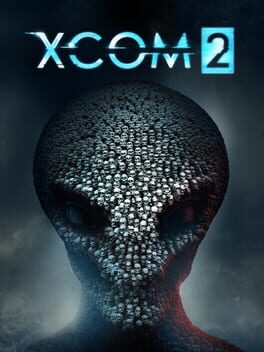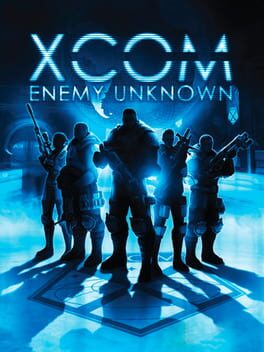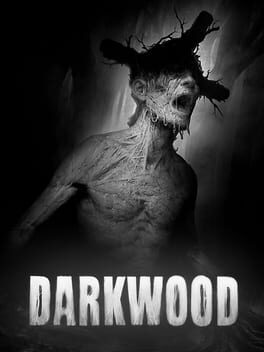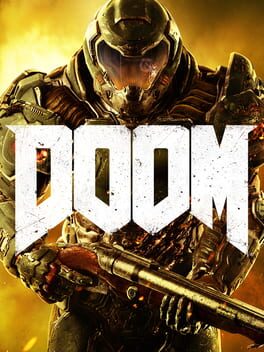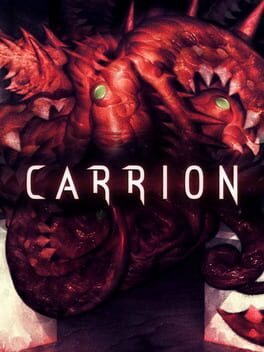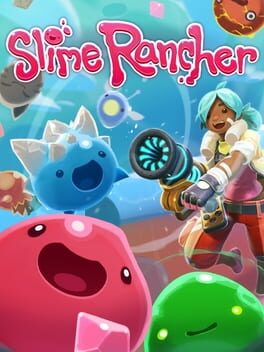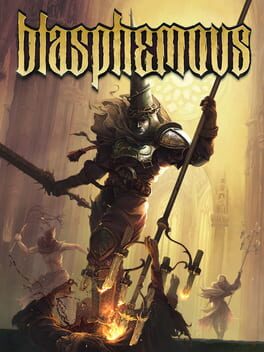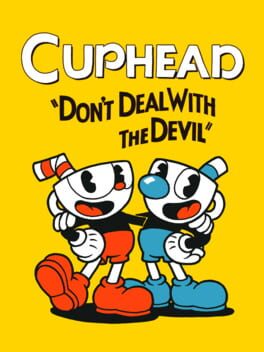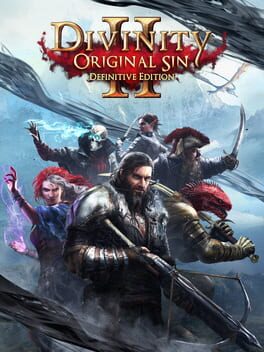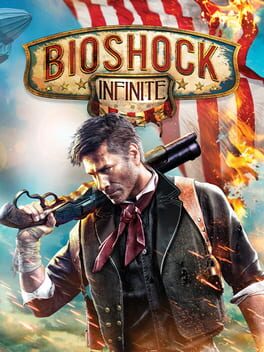PistolPumpkin
2016
If some apocalyptic event forced me to seal myself in a vault with just a single video game, XCOM 2 would be the one for me. No other game has given me such deeply satisfying tactical fun with near infinite replayability. I didn’t think the formula could get much better after Enemy Unknown, but XCOM 2 somehow took that gem and polished it to an even brighter shine.
The measured use of proc-gen for the maps, new classes and items, more diverse mission types, and vastly improved UI were all welcome, exciting changes. The timed missions were a bit contentious when it was introduced, but to me this was a much needed counterweight that kept the game right on balance between slow, methodical tactics and aggressive, calculated gambits.
And much like Enemy Within, I think the War of the Chosen DLC has become a crucial part of the complete XCOM 2 experience. The Chosen enemies and the new faction classes added great variety and replayability, and I especially enjoyed how the new bits of lore and campy storylines integrated so seamlessly into the emergent narratives. I’m sure every XCOM fan has a tale about a heartbreaking loss of their cherished Reaper, or a pitched battle for survival against a Chosen’s base assault. The DLCs really set XCOM 2 apart as a unique game with its own flavor and not just an iteration of its predecessor’s formula.
The measured use of proc-gen for the maps, new classes and items, more diverse mission types, and vastly improved UI were all welcome, exciting changes. The timed missions were a bit contentious when it was introduced, but to me this was a much needed counterweight that kept the game right on balance between slow, methodical tactics and aggressive, calculated gambits.
And much like Enemy Within, I think the War of the Chosen DLC has become a crucial part of the complete XCOM 2 experience. The Chosen enemies and the new faction classes added great variety and replayability, and I especially enjoyed how the new bits of lore and campy storylines integrated so seamlessly into the emergent narratives. I’m sure every XCOM fan has a tale about a heartbreaking loss of their cherished Reaper, or a pitched battle for survival against a Chosen’s base assault. The DLCs really set XCOM 2 apart as a unique game with its own flavor and not just an iteration of its predecessor’s formula.
2012
Years ago, I was introduced to the genre of turn-based tactics games with XCOM: Enemy Unknown, and for better or worse I was left chasing that incredible high ever since. The only other game that could provide that perfect mixture of strategy, risk management, and the iconic kick of RNG was none other than XCOM 2. While the sequel largely supplanted this one in terms of pure gameplay, every once in a while I still get the hankering to start a campaign in this atmospheric sci-fi horror setting to beat down aliens with my stompy mech soldiers.
But why was I so instantly captivated by this game? This wasn’t something I could easily answer at first while getting thoroughly obliterated as a newbie commander. That first campaign was confusing, brutal, yet still inexplicably fun. 1000 hours of play later, I’ve come to the conclusion that XCOM has the most perfect loop of interesting decisions and significant consequences constantly alternating one after another, keeping players invested all the way up until the endgame. The choices are weighty, varied, difficult but still intuitive to understand. Whether things go right or wrong, both newbies and veterans can always uncover a new layer of strategic depth.
I was hooked on this rapid and dynamic loop of learning, adapting, and gradually molding my troops into badass alien killers. My first campaign didn’t go very well, but as soon as it ended I was pumped to start the journey again with the knowledge that I had gained through my mistakes. Then I did it again, and again, until I finally won my first classic ironman campaign after a long, bloody war with a death toll in the 50s. That victory was one of the most memorable gaming moments in my life, and something I always hope to experience again when playing other strategy games.
But why was I so instantly captivated by this game? This wasn’t something I could easily answer at first while getting thoroughly obliterated as a newbie commander. That first campaign was confusing, brutal, yet still inexplicably fun. 1000 hours of play later, I’ve come to the conclusion that XCOM has the most perfect loop of interesting decisions and significant consequences constantly alternating one after another, keeping players invested all the way up until the endgame. The choices are weighty, varied, difficult but still intuitive to understand. Whether things go right or wrong, both newbies and veterans can always uncover a new layer of strategic depth.
I was hooked on this rapid and dynamic loop of learning, adapting, and gradually molding my troops into badass alien killers. My first campaign didn’t go very well, but as soon as it ended I was pumped to start the journey again with the knowledge that I had gained through my mistakes. Then I did it again, and again, until I finally won my first classic ironman campaign after a long, bloody war with a death toll in the 50s. That victory was one of the most memorable gaming moments in my life, and something I always hope to experience again when playing other strategy games.
2017
Darkwood was a fantastic horror game that delivered an unforgettable experience full of immersion, mystery, and pure dread. At a glance, the unusual top down perspective and the simple, pixelated art style didn’t seem very effective for the genre. However, this game showed me that the artistry of horror games was not in the graphics or in any particular camera perspective, but in its fluid mastery over atmosphere and tension.
From beginning to end, tension in Darkwood never really simmered down. From my first day in the cursed Polish woods I was scrambling to survive and prepare for the coming onslaught of spirits and monsters at night. Acid Wizard’s impeccably eerie sound design cast a sinister mood onto even the most tranquil of golden meadows, and indeed as I delved further into the forest, the beauty of nature gave way to reveal hidden nightmares in the shadows. At night, these nightmares launched full on attacks at my ramshackle cabin, and the desperate struggle to remain alive for one more minute, one more second, praying for the salvation of sunrise was more compelling than any horror set piece in higher budget games.
The world building of Darkwood often reminded me of Jeff Vendermeer’s Annihilation, a novel about a strange alien force that gradually refracts and assimilates all organic matter within its range to create illogical, monstrous, yet sometimes beautiful new creatures. It was a terrifying concept, and I loved exploring it again in Darkwood as well. My only gripe with the lore was that too much of it was obfuscated. I think I managed to piece together about 30% of the game’s full story. Most of my appreciation for Darkwood’s deep lore came from reading other people’s interpretations, and I wished these fascinating details had been more apparent during my playthrough.
I think having a more concrete story and gradual unraveling of the game’s mysteries would’ve helped immensely in the latter half of Darkwood. This game was a lot longer than I had expected it to be, and while the excellent gameplay and atmosphere stayed engaging for 20 hours or so, it became increasingly stretched and frayed past that mark. Gathering loot all day to prepare for another night in the woods was starting to feel like a chore, and I had long given up trying to look for any answers in the story. When I finally reached what looked like an ending I felt relieved and glad to finally let this amazing but overlong adventure conclude.
From beginning to end, tension in Darkwood never really simmered down. From my first day in the cursed Polish woods I was scrambling to survive and prepare for the coming onslaught of spirits and monsters at night. Acid Wizard’s impeccably eerie sound design cast a sinister mood onto even the most tranquil of golden meadows, and indeed as I delved further into the forest, the beauty of nature gave way to reveal hidden nightmares in the shadows. At night, these nightmares launched full on attacks at my ramshackle cabin, and the desperate struggle to remain alive for one more minute, one more second, praying for the salvation of sunrise was more compelling than any horror set piece in higher budget games.
The world building of Darkwood often reminded me of Jeff Vendermeer’s Annihilation, a novel about a strange alien force that gradually refracts and assimilates all organic matter within its range to create illogical, monstrous, yet sometimes beautiful new creatures. It was a terrifying concept, and I loved exploring it again in Darkwood as well. My only gripe with the lore was that too much of it was obfuscated. I think I managed to piece together about 30% of the game’s full story. Most of my appreciation for Darkwood’s deep lore came from reading other people’s interpretations, and I wished these fascinating details had been more apparent during my playthrough.
I think having a more concrete story and gradual unraveling of the game’s mysteries would’ve helped immensely in the latter half of Darkwood. This game was a lot longer than I had expected it to be, and while the excellent gameplay and atmosphere stayed engaging for 20 hours or so, it became increasingly stretched and frayed past that mark. Gathering loot all day to prepare for another night in the woods was starting to feel like a chore, and I had long given up trying to look for any answers in the story. When I finally reached what looked like an ending I felt relieved and glad to finally let this amazing but overlong adventure conclude.
2022
Scorn was one of very few games that I got excited for from the day of announcement and purchased immediately on the day of release. At the time, I felt my money would be well spent to simply see the haunting, surreal art of Giger and Beksinski come to life in a 3D interactive environment. In that aspect, Scorn delivered. The monstrous architectures forged from flesh and bone by some merciless, uncaring force completely captured my imagination. Bekskinski’s desolate, poignant hellscapes stretching across my screen had me stunned with awe.
All I wanted was to be fully immersed in these otherworldly environments, to traverse and explore at my own pace in contemplative isolation. Unfortunately, while Scorn was a brilliant experiential piece of art, it was also a bad video game. The combat was terrible and the puzzles were uninspired, but my biggest gripe was that these things existed in the game at all. Pistols, shotguns, keys, health stations, and puzzle minigames all felt like such contrived, gamey intrusions upon this exquisitely crafted universe.
Why were these eldritch, biomechanical fortresses designed to sculpt life from dead flesh being operated with simple block puzzles and maze puzzles? Did blasting shots into the tortured creatures really add anything to Scorn’s themes and story? The artists tried to camouflage these video game features with a Giger-esque aesthetic, but grafting some fleshy knobs and phallic frills to these gizmos didn’t really make them feel any less contrived. In this era of gaming where “walking simulator” titles such as Firewatch and Soma are celebrated, I don’t see why the devs couldn’t just cut the stale checklist of mechanics and let Scorn’s true strengths shine.
My biggest disappointment came after I had finished the game, when I was looking up information about Scorn’s worldbuilding. Google turned up an array of fantastic concept illustrations, bits of deep lore that were only mentioned in the artbook, and a variety of grotesque creature designs. Such imaginative ideas, all forever trapped in those pages, never to meet their potential. I’m glad I got to see some of that madness in this iteration of Scorn, but it’s disheartening to realize that something so beautiful was here on the cusp of emerging, only to perish during its molt.
All I wanted was to be fully immersed in these otherworldly environments, to traverse and explore at my own pace in contemplative isolation. Unfortunately, while Scorn was a brilliant experiential piece of art, it was also a bad video game. The combat was terrible and the puzzles were uninspired, but my biggest gripe was that these things existed in the game at all. Pistols, shotguns, keys, health stations, and puzzle minigames all felt like such contrived, gamey intrusions upon this exquisitely crafted universe.
Why were these eldritch, biomechanical fortresses designed to sculpt life from dead flesh being operated with simple block puzzles and maze puzzles? Did blasting shots into the tortured creatures really add anything to Scorn’s themes and story? The artists tried to camouflage these video game features with a Giger-esque aesthetic, but grafting some fleshy knobs and phallic frills to these gizmos didn’t really make them feel any less contrived. In this era of gaming where “walking simulator” titles such as Firewatch and Soma are celebrated, I don’t see why the devs couldn’t just cut the stale checklist of mechanics and let Scorn’s true strengths shine.
My biggest disappointment came after I had finished the game, when I was looking up information about Scorn’s worldbuilding. Google turned up an array of fantastic concept illustrations, bits of deep lore that were only mentioned in the artbook, and a variety of grotesque creature designs. Such imaginative ideas, all forever trapped in those pages, never to meet their potential. I’m glad I got to see some of that madness in this iteration of Scorn, but it’s disheartening to realize that something so beautiful was here on the cusp of emerging, only to perish during its molt.
2016
I never played the original Doom, so I was surprised to find that this classic shooter formula could feel so refreshing and new after 30 years. I very much enjoyed the purely aggressive gameplay, and while I usually prefer having a little more story in games, I could respect the decision to not get bogged down with too much writing. Besides, the Doom Slayer’s fiercely irreverent attitude towards Samuel Hayden and other major characters was very amusing.
Oh, and the music! I think at least half of this game’s experience was carried by its powerful metal soundtrack. A game like Doom that focuses on just one aspect of gameplay can feel repetitive after a while, but this soundtrack had a way of putting my brain in a trancelike state of flow with only a single directive: Rip and Tear. It was incredibly liberating to zip around the map, blasting demons while this intense battle music was thumping in my ears.
There were still some frustrating moments in the game, especially in the levels with excessive platforming and hoards of tankier enemies. Sometimes I didn’t feel much like a Doom Slayer but more like a fish in a barrel, especially as boss fights started to happen. So I ended up going back to the previous levels, tediously scouring the maps for secrets and challenges until I was fully upgraded. I know some people love hunting for secrets, but I wished gameplay upgrades weren’t so intertwined with those.
Despite the low points I still enjoyed Doom 2016 and appreciated its dedication to being a pure shooter first. Also the arcade mode was excellent. I still fire it up once in a while for some condensed action and stress relief. I’m so glad this game has led to the revival of classic shooters and I’m looking forward to trying more of them.
Oh, and the music! I think at least half of this game’s experience was carried by its powerful metal soundtrack. A game like Doom that focuses on just one aspect of gameplay can feel repetitive after a while, but this soundtrack had a way of putting my brain in a trancelike state of flow with only a single directive: Rip and Tear. It was incredibly liberating to zip around the map, blasting demons while this intense battle music was thumping in my ears.
There were still some frustrating moments in the game, especially in the levels with excessive platforming and hoards of tankier enemies. Sometimes I didn’t feel much like a Doom Slayer but more like a fish in a barrel, especially as boss fights started to happen. So I ended up going back to the previous levels, tediously scouring the maps for secrets and challenges until I was fully upgraded. I know some people love hunting for secrets, but I wished gameplay upgrades weren’t so intertwined with those.
Despite the low points I still enjoyed Doom 2016 and appreciated its dedication to being a pure shooter first. Also the arcade mode was excellent. I still fire it up once in a while for some condensed action and stress relief. I’m so glad this game has led to the revival of classic shooters and I’m looking forward to trying more of them.
2020
Carrion was a brilliant tentacle monster simulator for the first 3 hours that unfortunately receded to being a mediocre metroidvania as the novelty faded away. Granted, those early hours of the game were truly special. I loved watching my ball of gorey terror, animated with amazing detail and fluidity, bouncing around the labs in search of delicious humans. I had so much fun as I acted out thematic moments right out of monster flicks—hiding and crawling inside vents, snatching straggling soldiers while their comrades were distracted, and sometimes fully unleashing destruction by tearing apart the facility and painting the walls red.
But while these thematic moments were great hooks to get me into Carrion, the level designs weren’t strong enough to keep me engaged and sometimes even conflicted with the initial premise of the game. Why was I wasting so much time solving puzzles and delicately pulling levers with my tentacles, instead of eating people? Why was I wandering around the map, looking for some lame pipe-unplugging ability, and not just eating people? Why were the late game enemies so damn annoying, tanky, and terribly uneatable? All these gamey mechanics felt antithetical to the monstrous power fantasy I had been promised.
Thankfully, Carrion was a pretty short game. It didn’t take too long for the credits to roll after the initial rush of limb devouring mania waned. And while the late game was underwhelming, I could still find a few good monster moments in it. This game wasn’t quite as amazing as I hoped it would be, but it was still a couple hours of good fun. I’d recommend it at a discount if you’re a sci-fi horror fan.
But while these thematic moments were great hooks to get me into Carrion, the level designs weren’t strong enough to keep me engaged and sometimes even conflicted with the initial premise of the game. Why was I wasting so much time solving puzzles and delicately pulling levers with my tentacles, instead of eating people? Why was I wandering around the map, looking for some lame pipe-unplugging ability, and not just eating people? Why were the late game enemies so damn annoying, tanky, and terribly uneatable? All these gamey mechanics felt antithetical to the monstrous power fantasy I had been promised.
Thankfully, Carrion was a pretty short game. It didn’t take too long for the credits to roll after the initial rush of limb devouring mania waned. And while the late game was underwhelming, I could still find a few good monster moments in it. This game wasn’t quite as amazing as I hoped it would be, but it was still a couple hours of good fun. I’d recommend it at a discount if you’re a sci-fi horror fan.
2016
Slime Rancher was a strange game that consumed me for an entire week then quickly left my thoughts once I finished it. The gameplay loop of management, exploration, upgrades, and expansion was airtight with enough content to keep the dopamine juices flowing for 30 hours. The simple, colorful art style was very inviting, and the adorable slimes triggered a “gotta catch’em all” compulsion in me.
In short, it was the perfect game to sink time into during the covid lockdown era. The mechanics were varied enough to be entertaining but not complex enough to require much brain power. The story was some forgettably wholesome background noise about living life to the fullest. It wasn’t the kind of game I’d normally go for, but Slime Rancher delivered cozy satisfaction when I really needed it.
In short, it was the perfect game to sink time into during the covid lockdown era. The mechanics were varied enough to be entertaining but not complex enough to require much brain power. The story was some forgettably wholesome background noise about living life to the fullest. It wasn’t the kind of game I’d normally go for, but Slime Rancher delivered cozy satisfaction when I really needed it.
2019
The unique and evocative art of Blasphemous drew me in, and the world that kept unfolding with terrifyingly creative concepts and somber stories kept me playing it to the end. The themes about sin, suffering, and the dangerous entanglement of power and faith struck a chord with me, perhaps due to my own past struggles with religion. It seemed that the developers had detailed knowledge of this brand of Catholicism, imbuing the setting with cultural authenticity beyond just the aesthetics.
Although I must admit, the art certainly played a huge role in my enjoyment of Blasphemous. The general gameplay was fine but nothing innovative or special. The platforming wasn’t very precise, but was serviceable because most of the levels didn’t demand extreme precision. I loved the fascinating concepts for the traversal upgrades, but in practice actual movement never evolved beyond the basic jumps, wall jumps, and dashing. However, Blasphemous still excelled at the one thing that I crave most from metroidvanias: exploration.
I thoroughly enjoyed every moment I spent wandering around, losing my bearings and getting assailed by strange creatures and tortured souls in the cursed lands of Cvstodia. Every new region, enemy, and NPC were so strikingly unique and mysterious that I simply had to dive deeper and learn more about them. Even as I neared the end, I was still excited to fill out the rest of the map, backtracking to every dark corner just to see a little more of the world. It also helped that I enjoyed the combat, which was a very good 2D translation of the soulslike style.
Despite a bit of jank and some strange game design decisions, I found Blasphemous to be a unique experience much greater than the sum of its parts. It’s not the kind of game that would work for everyone, but it certainly has a strong draw with a particular audience of lore lovers and explorers.
Although I must admit, the art certainly played a huge role in my enjoyment of Blasphemous. The general gameplay was fine but nothing innovative or special. The platforming wasn’t very precise, but was serviceable because most of the levels didn’t demand extreme precision. I loved the fascinating concepts for the traversal upgrades, but in practice actual movement never evolved beyond the basic jumps, wall jumps, and dashing. However, Blasphemous still excelled at the one thing that I crave most from metroidvanias: exploration.
I thoroughly enjoyed every moment I spent wandering around, losing my bearings and getting assailed by strange creatures and tortured souls in the cursed lands of Cvstodia. Every new region, enemy, and NPC were so strikingly unique and mysterious that I simply had to dive deeper and learn more about them. Even as I neared the end, I was still excited to fill out the rest of the map, backtracking to every dark corner just to see a little more of the world. It also helped that I enjoyed the combat, which was a very good 2D translation of the soulslike style.
Despite a bit of jank and some strange game design decisions, I found Blasphemous to be a unique experience much greater than the sum of its parts. It’s not the kind of game that would work for everyone, but it certainly has a strong draw with a particular audience of lore lovers and explorers.
2023
I love both action games and rhythm games, so I thought HI-Fi Rush would be perfect for me when I saw its genre mashing gameplay and vibrant artstyle. But as much as I wanted to enjoy it, I could never really get into a groove with this game because I was constantly hurdling over little annoyances and interruptions in order to get to the fun parts. I still stuck around for the delightful spectacle and animations, but overall it ended up being a near miss for me.
The main issue was the very slow buildup of mechanics and difficulty. The elongated tutorial and very basic early game probably helped to introduce this unique genre mixture to many players, but it didn’t quite work for me. Hours into Hi-Fi Rush, I was still waiting for the gameplay to drop the beat and actually start. I was already half way through the game by the time the combat ramped up enough to be interesting and challenging. Even then, the good combat sections tended to be too short for my tastes, frequently interrupted by pointless dialogue and very clunky platforming.
I also disliked that Chai was always hitting things on beat even when my inputs were off. This might be an odd complaint, but I wanted to easily see what I was doing wrong when I wasn’t getting the “good” or “perfect” beats. Was I too slow with that attack, or too fast? I couldn’t know, but it also didn’t matter because Chai was doing his rock star thing regardless of my mistakes. The guardrails eliminated the lows of defeat, but also flattened the highs of victory.
After the credits rolled I did consider getting into the new game+ with maybe a bump in difficulty, but I realized I’d have to endure the terrible story again. Nothing in the writing worked for me. The humor rarely landed, the characters were awfully two dimensional, and Chai was an embodiment of the insufferable “idiot hero” trope. It would’ve been fine if the dialogue was contained in easily skippable cutscenes and I could forget about the characters during gameplay. But no, the chatter was constant, while I just wanted to listen to music and smash some robots.
So forgoing the new game+, I gave the arcade modes a try. These were actually pretty fun, and were closer to the experience I was looking for from the beginning. No interruptions, no platforming, just pure rhythm combat. I didn’t get too far into it because I was ready to move on to other games by then, but if I ever went back to HI-Fi Rush again, I’d be sticking to that little arcade machine.
The main issue was the very slow buildup of mechanics and difficulty. The elongated tutorial and very basic early game probably helped to introduce this unique genre mixture to many players, but it didn’t quite work for me. Hours into Hi-Fi Rush, I was still waiting for the gameplay to drop the beat and actually start. I was already half way through the game by the time the combat ramped up enough to be interesting and challenging. Even then, the good combat sections tended to be too short for my tastes, frequently interrupted by pointless dialogue and very clunky platforming.
I also disliked that Chai was always hitting things on beat even when my inputs were off. This might be an odd complaint, but I wanted to easily see what I was doing wrong when I wasn’t getting the “good” or “perfect” beats. Was I too slow with that attack, or too fast? I couldn’t know, but it also didn’t matter because Chai was doing his rock star thing regardless of my mistakes. The guardrails eliminated the lows of defeat, but also flattened the highs of victory.
After the credits rolled I did consider getting into the new game+ with maybe a bump in difficulty, but I realized I’d have to endure the terrible story again. Nothing in the writing worked for me. The humor rarely landed, the characters were awfully two dimensional, and Chai was an embodiment of the insufferable “idiot hero” trope. It would’ve been fine if the dialogue was contained in easily skippable cutscenes and I could forget about the characters during gameplay. But no, the chatter was constant, while I just wanted to listen to music and smash some robots.
So forgoing the new game+, I gave the arcade modes a try. These were actually pretty fun, and were closer to the experience I was looking for from the beginning. No interruptions, no platforming, just pure rhythm combat. I didn’t get too far into it because I was ready to move on to other games by then, but if I ever went back to HI-Fi Rush again, I’d be sticking to that little arcade machine.
2017
It took me several restarts to get into the mindset needed to appreciate Cuphead, but once I was able to find the fun in meeting its challenges, it became one of my favorite gaming experiences ever. I had very little prior experience of playing these types of precise platformers or 2D bullet hell games, so the learning curve was especially steep for me. It was certainly frustrating at first, but eventually the joyous jazz music, the beautiful animations, and the sheer creativity of the enemy and level designs motivated me to push through until I managed to beat a few bosses.
That’s when Cuphead finally clicked for me. I was no longer disheartened by repeated deaths because I had confidence that I would get better and meet the challenge. Each retry became another opportunity to enjoy the exhilarating gameplay and the lovingly crafted spectacle. The progress meter that displayed after each attempt was an excellent idea from the developers, because seeing my little cup going a bit farther each time gave me tangible feedback on my improving skills. I kept coming back thinking, “This time will be the one!” Then after each delicious “Knockout!” on a hard boss, I fell in love with Cuphead a little more.
That’s when Cuphead finally clicked for me. I was no longer disheartened by repeated deaths because I had confidence that I would get better and meet the challenge. Each retry became another opportunity to enjoy the exhilarating gameplay and the lovingly crafted spectacle. The progress meter that displayed after each attempt was an excellent idea from the developers, because seeing my little cup going a bit farther each time gave me tangible feedback on my improving skills. I kept coming back thinking, “This time will be the one!” Then after each delicious “Knockout!” on a hard boss, I fell in love with Cuphead a little more.
2010
A Stephen King inspired horror game about a depressed writer cursed with supernatural creative powers sounded like a perfect premise for me. I expected to be terrified, lost, and fully engrossed in a dark and atmospheric setting, but the only quality I found that this game shared with Stephen King’s novels was a desperate need for an editor.
Alan Wake was only a 10 hour game yet it somehow still felt too long. I can usually appreciate a slow burn horror, but the flat, tropey characters failed to carry the narrative and I struggled to get invested in them. It also didn’t help that the story was doled out in pieces between extremely repetitive and dull combat sections. The gameplay loop was very basic: press a button to shine a light, then press another button to shoot a gun. It never evolved or deviated past this loop, like playing a tutorial from beginning to end. The enemies were mostly copy-pasted shadow men, or occasionally when the Darkness wanted to spice it up, some shadow birds or trucks. The reward for finishing these encounters was a bit of cutscene narrated with Alan’s stodgy monologue.
This game was such a disappointment for me because I jumped into it right after having a wonderful time with Remedy’s more recent title, Control. I was ready to learn more about their “Remedy-verse” and wanted to connect the dots in the lore myself by playing all of their older games. Alan Wake quickly put an end to that endeavor, and I’m now happy to just read about the cool details on a wiki.
Alan Wake was only a 10 hour game yet it somehow still felt too long. I can usually appreciate a slow burn horror, but the flat, tropey characters failed to carry the narrative and I struggled to get invested in them. It also didn’t help that the story was doled out in pieces between extremely repetitive and dull combat sections. The gameplay loop was very basic: press a button to shine a light, then press another button to shoot a gun. It never evolved or deviated past this loop, like playing a tutorial from beginning to end. The enemies were mostly copy-pasted shadow men, or occasionally when the Darkness wanted to spice it up, some shadow birds or trucks. The reward for finishing these encounters was a bit of cutscene narrated with Alan’s stodgy monologue.
This game was such a disappointment for me because I jumped into it right after having a wonderful time with Remedy’s more recent title, Control. I was ready to learn more about their “Remedy-verse” and wanted to connect the dots in the lore myself by playing all of their older games. Alan Wake quickly put an end to that endeavor, and I’m now happy to just read about the cool details on a wiki.
Divinity Original Sin 2 had everything I wanted from CRPGs. Rivellon was a huge, immersive and dynamic world, full of secrets to uncover and memorable conflicts to stumble upon in every corner. The story had a somewhat generic start, but was quickly elevated by its cast of interesting origin characters. I was also impressed by how reactive the game was to my decisions, with verisimilitude both in and out of combat. Although I’m usually indifferent towards these typical fantasy settings, I ended up caring deeply about the world and its fate because of my great degree of influence within it.
The combat was amazing. The elemental effects were very fun to manipulate and intuitive to learn, and the armor system added a tactical puzzle that was satisfying to crack. The enemies proved to be quite competent tacticians, and combined with the unique terrain each encounter was designed around, they provided a good amount of challenge that encouraged experimentation. To support this, the game also had great player freedom and lots of tools to tinker with. I could easily respec at any time to try different builds. The crafting system was robust and useful. Skills like teleportation and terrain transmutation rewarded creative thinking on the battlefield with great advantages. I could bend the game as much as I wanted but it never seemed to actually break, but instead became more fun.
This game was very close to perfection for me, but it still had a few flaws that others might find more problematic. The difficulty curve could’ve been smoother, as it was the harshest in the early game and required a bit of XP scrounging until the gameplay opened up. Fortunately DOS2 has easier difficulties available, and a “gift bag” feature that allows players to tune their playthrough with developer supported mods. I also had some issues with the writing in certain spots of the story, especially the ending which felt like a series of rushed revelations and some plot hole ridden choices.
Still, I think the depth and quality of content in DOS2 completely makes up for its shortcomings. It’s no surprise that Larian was able to succeed so well with Baldur’s Gate 3, as the brilliance of that game can be traced directly from DOS2. I’m still hoping they will come back to this series afterwards, because there’s a lot here that can still be explored and fleshed out. Also I just want more games with this incredibly satisfying combat system.
The combat was amazing. The elemental effects were very fun to manipulate and intuitive to learn, and the armor system added a tactical puzzle that was satisfying to crack. The enemies proved to be quite competent tacticians, and combined with the unique terrain each encounter was designed around, they provided a good amount of challenge that encouraged experimentation. To support this, the game also had great player freedom and lots of tools to tinker with. I could easily respec at any time to try different builds. The crafting system was robust and useful. Skills like teleportation and terrain transmutation rewarded creative thinking on the battlefield with great advantages. I could bend the game as much as I wanted but it never seemed to actually break, but instead became more fun.
This game was very close to perfection for me, but it still had a few flaws that others might find more problematic. The difficulty curve could’ve been smoother, as it was the harshest in the early game and required a bit of XP scrounging until the gameplay opened up. Fortunately DOS2 has easier difficulties available, and a “gift bag” feature that allows players to tune their playthrough with developer supported mods. I also had some issues with the writing in certain spots of the story, especially the ending which felt like a series of rushed revelations and some plot hole ridden choices.
Still, I think the depth and quality of content in DOS2 completely makes up for its shortcomings. It’s no surprise that Larian was able to succeed so well with Baldur’s Gate 3, as the brilliance of that game can be traced directly from DOS2. I’m still hoping they will come back to this series afterwards, because there’s a lot here that can still be explored and fleshed out. Also I just want more games with this incredibly satisfying combat system.
2017
Prey raised the bar for “immersive” in the immersive sim genre to a whole new level for me. Coming from the Bioshock series, I was so happy to see the familiar formula become perfected in this game, with so much more player expression and freedom put into combat, traversal, and story. I loved the incredible detail and interconnectedness in the gameplay systems which also fit seamlessly into the setting. The sheer variety of builds and skills I could play with were overwhelming at times, but also added great replay potential.
Talos 1 was a meticulously crafted setting that never became reduced to just a video game arena designed for me to run around shooting aliens in. Despite the massive scale of the station, each area was always fleshed out with grounded details that made it feel like a real place where people with distinct personalities and histories lived their lives. Exploring through the crew’s workstations full of emails and notes, their personal rooms decorated with children’s art and DnD character sheets, I felt like I was getting to know these people even though I would never get to actually meet them.
I was also impressed with the quality of writing and the decisions Prey presented me with. In a lot of games with moral choices, the options often boil down to “good” or “bad,” and there is barely any room to leave me wondering if I made the right choice. But in Prey, there were multiple sections where I had to pause the game just to ponder the decision I was being asked to make.
Unfortunately, my experience took a slight downturn towards the end. The tension that had gripped me in the beginning eventually fizzled out as I amassed resources and neuromod powers. I was running fearlessly around Talos 1 spraying ammo at anything that looked remotely suspicious. Even the titanic “Nightmare” started to feel like a lumbering oaf, existing solely to waste my time killing it. The ending was also strange. I hesitate to say “bad” because it was shocking and interesting on its own, but I was hoping for more satisfying resolutions to all the difficult moral decisions I had to make throughout the story.
Despite its weak ending, I would still recommend Prey to anyone looking for a great immersive sim. The journey matters more than the destination after all. I think Prey brings much more to the table than other games with a similar premise, especially for people who love to explore and experiment in a game.
Talos 1 was a meticulously crafted setting that never became reduced to just a video game arena designed for me to run around shooting aliens in. Despite the massive scale of the station, each area was always fleshed out with grounded details that made it feel like a real place where people with distinct personalities and histories lived their lives. Exploring through the crew’s workstations full of emails and notes, their personal rooms decorated with children’s art and DnD character sheets, I felt like I was getting to know these people even though I would never get to actually meet them.
I was also impressed with the quality of writing and the decisions Prey presented me with. In a lot of games with moral choices, the options often boil down to “good” or “bad,” and there is barely any room to leave me wondering if I made the right choice. But in Prey, there were multiple sections where I had to pause the game just to ponder the decision I was being asked to make.
Unfortunately, my experience took a slight downturn towards the end. The tension that had gripped me in the beginning eventually fizzled out as I amassed resources and neuromod powers. I was running fearlessly around Talos 1 spraying ammo at anything that looked remotely suspicious. Even the titanic “Nightmare” started to feel like a lumbering oaf, existing solely to waste my time killing it. The ending was also strange. I hesitate to say “bad” because it was shocking and interesting on its own, but I was hoping for more satisfying resolutions to all the difficult moral decisions I had to make throughout the story.
Despite its weak ending, I would still recommend Prey to anyone looking for a great immersive sim. The journey matters more than the destination after all. I think Prey brings much more to the table than other games with a similar premise, especially for people who love to explore and experiment in a game.
2017
As a narrative and exploration focused gamer, I had never been a fan of difficult bosses. They always felt like solid brick walls built to ruin the flow of exploration, and I’d have to smash myself against them repeatedly for hours to get through. Easy mode was my usual solution if it was available. I thought I would never understand how some people could enjoy this frustrating aspect of gaming, so much so there was even a whole genre dedicated to it.
But then, I tried Hollow Knight. It was the first game ever I managed to “get good” at. It was the first game that taught me what getting good even means, how to do it, and most importantly, how it could be fun. Hollow Knight was a perfectly tuned game for bridging the gap between exploration and challenge. The platforming controls were smooth and precise. New abilities were introduced at a steady pace, accompanied with intuitive level design that naturally encouraged experimentation and mastery. The clean art style with minimal visual noise, along with excellent sound design, rendered even the most difficult enemies very readable and learnable.
Yes I died a lot, but each time my skill and knowledge of the game was increasing. As I slowly overcame the challenges that I had thought impossible, I was also getting hooked on that sweet dopamine rush of victory. Even after the credits rolled I was still obsessed, going for that 112% completion. I was happy to spend weeks conquering all the crazy challenges and bosses the game had to offer.
Of course, it wasn’t just about the arduous battles. This beautiful fallen kingdom of bugs was also replete with great characters, tragedies, comedies, and secrets. Even as I approached the endgame I was still discovering whole new areas, all illustrated lovingly with distinct styles and packed with great content. I didn’t expect to become so attached to Hallownest and its insect residents, but by the end I was fully invested in all their stories.
I know that Hollow Knight doesn’t fit neatly into the Souls-like genre, but it certainly opened my mind to those games that I had previously avoided. I can now explore a whole new corner of my favorite hobby with a fresh perspective and newfound confidence, thanks to this game. Hollow Knight was one of the most memorable and exciting adventures I’ve had in gaming.
But then, I tried Hollow Knight. It was the first game ever I managed to “get good” at. It was the first game that taught me what getting good even means, how to do it, and most importantly, how it could be fun. Hollow Knight was a perfectly tuned game for bridging the gap between exploration and challenge. The platforming controls were smooth and precise. New abilities were introduced at a steady pace, accompanied with intuitive level design that naturally encouraged experimentation and mastery. The clean art style with minimal visual noise, along with excellent sound design, rendered even the most difficult enemies very readable and learnable.
Yes I died a lot, but each time my skill and knowledge of the game was increasing. As I slowly overcame the challenges that I had thought impossible, I was also getting hooked on that sweet dopamine rush of victory. Even after the credits rolled I was still obsessed, going for that 112% completion. I was happy to spend weeks conquering all the crazy challenges and bosses the game had to offer.
Of course, it wasn’t just about the arduous battles. This beautiful fallen kingdom of bugs was also replete with great characters, tragedies, comedies, and secrets. Even as I approached the endgame I was still discovering whole new areas, all illustrated lovingly with distinct styles and packed with great content. I didn’t expect to become so attached to Hallownest and its insect residents, but by the end I was fully invested in all their stories.
I know that Hollow Knight doesn’t fit neatly into the Souls-like genre, but it certainly opened my mind to those games that I had previously avoided. I can now explore a whole new corner of my favorite hobby with a fresh perspective and newfound confidence, thanks to this game. Hollow Knight was one of the most memorable and exciting adventures I’ve had in gaming.
2013
Bioshock Infinite was my introduction to this great series, and for that it will always have a special place in my heart. In my replays I’ve come to see more of its faults, but I think it’s still a very fun game with a new glamorously horrifying city that deserves its place right alongside Rapture.
At first I was completely charmed by this deific steampunk paradise. I loved walking its floating streets, eavesdropping on conversations, listening to the music, savoring the immersion. I didn’t know what to expect from a Bioshock game back then, so I was genuinely shocked when things went to hell and Columbia turned out to be a white supremacist theme park. I still tried to explore as much as I could between fighting off the sky KKKs, but a layer of apprehension always tainted the city’s grandeur which I found dreadfully compelling.
I loved the combat on my first playthrough. I wasn’t very good at FPS games so the stylish yet simple combat worked well for me. However after playing the previous Bioshock entries, Infinite’s combat started to feel too restrictive in comparison. I missed the immersive-sim elements from the first game and the degree of playstyle variety it granted. At least the skylines were great additions, and stomping on enemies from 10 meters high never got dull.
I also had some misgivings about the story which only deepened on replays. With racism and oppression featuring prominently through the hook and buildup of the story, I felt like there should’ve been a stronger message underneath to support these heavy topics. I wasn’t satisfied with the way this crucial aspect of the setting was dismissed with a banal “people are all bad” conclusion. Booker and Elizabeth’s multiverse adventure was fun and all, but the Vox Populi story shouldn’t have been relegated to mere backdrop.
Bioshock Infinite is a very well crafted entertainment product. It’s got style, cool characters, shocking twists, and plenty of spectacle. The setting and the story is fascinating. Gameplay is fun. But it’s not a thoughtful or deep philosophical media like it tries so very hard to be. There’s a whole mess of neat ideas in it that could’ve become truly great with thoughtful writing and design, but instead they all crudely got shoved into a single 15 hour game. I would still love to experience the stories within other lighthouses and their dangerously enthralling cities, but hopefully with better writing and less multiverse shenanigans.
At first I was completely charmed by this deific steampunk paradise. I loved walking its floating streets, eavesdropping on conversations, listening to the music, savoring the immersion. I didn’t know what to expect from a Bioshock game back then, so I was genuinely shocked when things went to hell and Columbia turned out to be a white supremacist theme park. I still tried to explore as much as I could between fighting off the sky KKKs, but a layer of apprehension always tainted the city’s grandeur which I found dreadfully compelling.
I loved the combat on my first playthrough. I wasn’t very good at FPS games so the stylish yet simple combat worked well for me. However after playing the previous Bioshock entries, Infinite’s combat started to feel too restrictive in comparison. I missed the immersive-sim elements from the first game and the degree of playstyle variety it granted. At least the skylines were great additions, and stomping on enemies from 10 meters high never got dull.
I also had some misgivings about the story which only deepened on replays. With racism and oppression featuring prominently through the hook and buildup of the story, I felt like there should’ve been a stronger message underneath to support these heavy topics. I wasn’t satisfied with the way this crucial aspect of the setting was dismissed with a banal “people are all bad” conclusion. Booker and Elizabeth’s multiverse adventure was fun and all, but the Vox Populi story shouldn’t have been relegated to mere backdrop.
Bioshock Infinite is a very well crafted entertainment product. It’s got style, cool characters, shocking twists, and plenty of spectacle. The setting and the story is fascinating. Gameplay is fun. But it’s not a thoughtful or deep philosophical media like it tries so very hard to be. There’s a whole mess of neat ideas in it that could’ve become truly great with thoughtful writing and design, but instead they all crudely got shoved into a single 15 hour game. I would still love to experience the stories within other lighthouses and their dangerously enthralling cities, but hopefully with better writing and less multiverse shenanigans.
